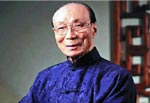Homeward-bound Buddhas
Updated: 2014-01-16 10:26
By Han Bingbin (China Daily)
|
||||||||
 |
|
Taiwan collector Andy Yeh [Photo provided to China Daily] |
 |
They were then bought by entrepreneurs or aristocrats, in Europe especially, who have a passion for oriental culture.
"In international auctions, foreign buyers usually care more about the appearances of Buddha statues. To them, the historical value doesn't seem to matter as much as it does to us," says Lin.
Lin adds that's why Buddha statues made in the Tang and Song (960-1279) dynasties, which display a style of realistic art favored by Westerners, tend to be treated as the highlights of their collections. Buddha statues of the Northern Qi Dynasty have been also gaining more recognition and interest worldwide over the past few decades because they were arguably influenced by the art of the Gupta Empire (a phase of ancient India), which entered what is today's Shandong province through the Maritime Silk Road."From 1949 to the 'cultural revolution' (1966-76), the Chinese mainland cut off its connection with the outside world. Unable to enter the country, the second or third generations of those collectors don't have the emotional attachment to the country, unlike their fathers," says Lin.
|
 |
|
 |
|
 |
Lin says that's also the reason why they're willing to sell their family collections in the first place. From the 1970s, antique dealers started to find treasures from their gardens and sell them to international markets.
In the 1980s, Taiwan started to embrace a fast-growing economy and a more open society, both contributing to the formation of a culturally aware elite group who were willing to invest in cultural relics. That's why when Chinese cultural relics entered the Asian market, with Hong Kong normally being the first stop, entrepreneurs from Taiwan were usually among the first group of buyers.
In the past decade, Chinese cultural relics owned by Taiwan collectors started to draw attention in markets including the Chinese mainland.
For example, a few of the controversial bronze zodiac animal head statues at the Old Summer Palace were reportedly once owned by Taiwan collectors. In 2007, four national treasures owned by Taiwan collectors, including the Four Sheep Copper Pots of the Spring and Autumn Period (770-476 BC), appeared in an autumn auction in Beijing.
Taiwan has been an important source of cultural relic donations to the Chinese mainland. In 1999, Taiwan entrepreneur Chen Yung-tai bought 18 arhat head sculptures from overseas and gave them back to the Zishou Temple in Shanxi province. In 2002, a Buddha head was donated to the Shentong Temple in Shandong province by Master Sheng-Yen on behalf of Taiwan's Dharma Drum Mountain.
Yeh's donation is the third such gift in history. In Henan's Zhengyang county, the local government is planning to rebuild a small temple to accommodate the statue. Local residents are also returning the stone plaque they kept after the original temple was demolished.
"The return of the ancient statue to Zhengyang will not only enhance the communication across the Straits, but also stimulate local cultural tourism," says Yeh.
"After hearing about the return of the statue, many people went to worship it. This will push the government to pay more attention to the preservation of cultural relics."

 Gorgeous Liu Tao poses for COSMO magazine
Gorgeous Liu Tao poses for COSMO magazine
 Post-baby Duchess
Post-baby Duchess
 Victoria Beckham S/S 2014 presented during NYFW
Victoria Beckham S/S 2014 presented during NYFW
 'Despicable' minions upset Depp's 'Lone Ranger' at box office
'Despicable' minions upset Depp's 'Lone Ranger' at box office
 'Taken 2' grabs movie box office crown
'Taken 2' grabs movie box office crown
 Rihanna's 'Diamonds' tops UK pop chart
Rihanna's 'Diamonds' tops UK pop chart
 Fans get look at vintage Rolling Stones
Fans get look at vintage Rolling Stones
 Celebrities attend Power of Women event
Celebrities attend Power of Women event
Most Viewed
Editor's Picks

|

|

|

|

|

|
Today's Top News
Majoring in anti-money laundering
China's airlines ready for rush
Draft law: Clean up air or pay fine
Park venues targeted in corruption drive
IMF faults Congress' budget
Year of the Horse stamp issued
China seeks to calm US fears over missile
Doubt on Tokyo's diplomatic push
US Weekly

|

|








